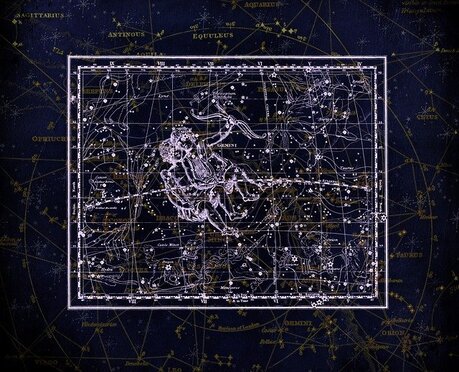 Gemini Image by DarkmoonArt_de from Pixabay Gemini Image by DarkmoonArt_de from Pixabay To me, constellations are like an invitation to study and research: not only are they beautiful to watch, but they have an awesome scientific and historical aspect. The word itself, “constellation”, sounds unique: it comes from Latin: “con” means together, and “stella” was the word the late language used to refer to stars. Astronomers have found 88 constellations in the sky. According to Wikipedia, “a constellation is an area in the sky in which a group of stars forms an outline or pattern”. Here comes the interesting part: “These can represent animals, mythological people, creatures, and inanimate objects." The earliest accepted evidence on constellations we have is from prehistoric times, from Mesopotamia, now known as the Middle East: people made-up stories about them and created different beliefs, such as the influence on human behavior based on the position of a celestial object. According to their clay writing tablets, dating back to 3000 BC, Babylonian astronomy was the first to: apply math to their predictions, possess an accurate theory of the planets, and focus observation on a group of stars, known as Ziqpu stars. The classical Zodiac is a revision of the Neo-Babylonian Empire’s constellations. Greek astronomy adopted the Babylonian system, first introduced by Eudoxus of Cnidus. It is a crucial phase in the history of astronomy, as they inspired the names of most stars, planets and constellations: some are tied to mythology, such as Orion and Aquila; some are astrological signs, such as Gemini and Leo, connected historically and scientifically in a manner that always makes me thankful for astronomers' time and effort put into all these discoveries. The northern hemisphere and southern skies are different: most of the northern constellations are based on Greek legends, such as the hunter Orion; the southern ones have more modern roots, sometimes shortened names of ancient constellations. Constellations are made up of stars representing an image, and only those visible to the naked eye are part of constellations. I would like to share a few definitions about stars that I found in my Science notebook from sixth grade: Apparent Brightness is how bright the star is as seen from Earth Absolute Brightness is how bright it actually is  Credit: European Southern Observatory Credit: European Southern Observatory As the star gets cooler, it tends to get dimmer, and as it gets hotter, it gets brighter. How bright it looks from Earth depends upon its size, its distance from Earth and its absolute brightness. They can appear brighter or dimmer depending on these factors. Stars also have different colors, which depend on their surface temperature. Red is the coolest, followed by yellow, white and blue being the hottest. Thus, even though Betelgeuse is a red star and the Sun is a yellow-orange star, Betelgeuse gives off more light, given its size. I also learned in science about the Hertzsprung-Russell diagram (H-R diagram), that compares two very important characteristics of stars: the temperature and absolute brightness. Astronomers use it to understand how stars change over time. Most of the stars form a diagonal line called the main sequence, where surface temperatures increase as brightness increases. The stars, far away in space, stay in one place, while Earth spins on its axis, as well as orbiting the sun, which causes the stars to appear to “move”. Earth also orbits the sun. We see different stars, depending on what side of Earth we are. Constellations are more than just a group of stars. Throughout the ages, people have used them to share stories and develop scientific ideas. Modern astronomy consists of these stars, and is, in my opinion, an extraordinary field. Thanks to many awesome people who develop modern technology, we have the opportunity to stargaze at home, just by downloading one of the multiple apps that facilitate easy access to seeing constellations, stars and countless other space objects. Thank you to my science teacher, Ms. Edwards, who helped me navigate the mysteries of science in sixth grade and also thank you all for reading! Wishing all the students a successful academic year! Read Stephanie's previous blog - When STEM helps us reach for the stars.
Ana
27/9/2020 08:43:20 pm
Excellent! :)
Di
28/9/2020 11:28:16 pm
I love it!
Corina Manuc
29/9/2020 12:32:52 am
Stefi, it is very interesting your article about constellations! It is documented and very nice structured! Can't wait to read your next article! Great job!
Minodora
29/9/2020 01:38:39 am
So priud of you, Stephanie! Well written and promising. Congratulations and looking forward to reading more!
Madalina
29/9/2020 04:50:08 am
Woawww. Those are very interesting informations! Keep up thegood work, Stefi!
Diana L (auntie)
29/9/2020 06:19:34 am
Yey, very good Stephanie!!!!!
Nemeș Mihai
29/9/2020 08:33:04 am
Congratulations Stephanie! Very interesting information. Keep it like this, the good work . Hug from Alba Iulia!
Miruna
2/10/2020 06:31:03 am
Excellent article, Stefi! Looking forward to reading the next one! Comments are closed.
|
Welcometo the InnovaSpace Knowledge Station Categories
All
|
UK Office: 88 Tideslea Path, London, SE280LZ
Privacy Policy I Terms & Conditions
© 2024 InnovaSpace, All Rights Reserved

 RSS Feed
RSS Feed